
Litoria is a genus of hylid tree frogs, sometimes collectively referred to as Australasian treefrogs.

The marsupial family Peramelidae contains the extant bandicoots. They are found throughout Australia and New Guinea, with at least some species living in every available habitat, from rainforest to desert. Four fossil peramelids are described. One known extinct species of bandicoot, the pig-footed bandicoot, was so different from the other species, it was recently moved into its own family.

The Arfak astrapia is a species of astrapia, a group of birds found in the birds-of-paradise family Paradiseidae.

The long-tailed paradigalla is a large, approximately 37 cm long, black bird-of-paradise with long and pointed tail. One of the most plain members in the family Paradisaeidae, its only adornment is the colorful facial wattles of yellow, red and sky-blue near base of the bill. Both sexes are similar in appearance, however the female is slightly duller and smaller.
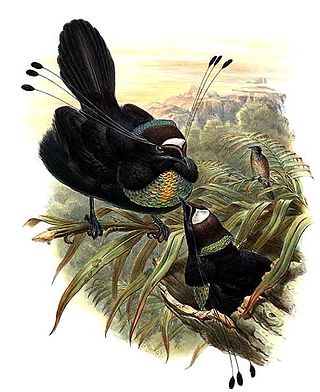
The western or Arfak parotia is a medium-sized, approximately 33 cm long, bird-of-paradise with a medium-length tail.
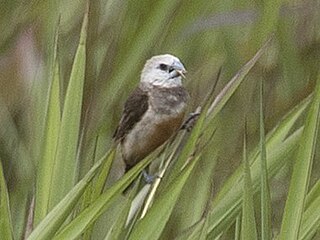
The grey-banded mannikin, or grey-banded munia, is a species of estrildid finch known to be found in Anggi Gigi, Tamrau Mountains, and Arfak Mountains in the Vogelkop Peninsula in north-western Papua, Indonesia. This species inhabits mid-mountain wet grassland and marshland. It also can be found on abandoned agricultural plots near human settlements.
The Arfak Mountain tree frog is a species of frog in the subfamily Pelodryadinae. It is endemic to West Papua, Indonesia. Its natural habitats are subtropical or tropical moist montane forests, rivers, rural gardens, and heavily degraded former forest. The threats are not known and is thought to be locally protected and occurs in Arfak Mountains National Park.
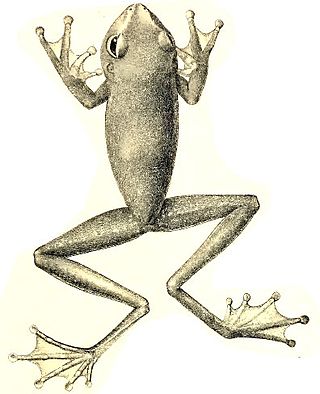
Nyctimystes montanus is a species of frog in the subfamily Pelodryadinae. It is endemic to the Arfak Mountains, located in the Bird's Head Peninsula of northwestern New Guinea. This species is only known from its type locality. There are no records of this species after it was described in 1878, perhaps because of lack of surveys.

The modest tiger parrot is a species of parrot in the family Psittaculidae. It is found in the Arfak Mountains and New Guinea Highlands. Its natural habitat is subtropical or tropical moist montane forests.
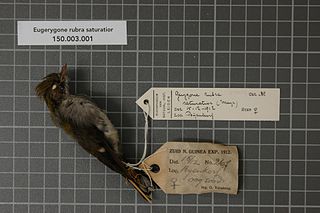
The garnet robin is a species of bird in the family Petroicidae. It is monotypic within the genus Eugerygone. It is found in New Guinea, where its natural habitat is subtropical or tropical moist montane forests.

The striped bandicoot is a species of marsupial in the family Peramelidae. It is found in West Papua and Papua New Guinea. Its natural habitat is subtropical or tropical dry forests. The Striped bandicoot is a host of the Acanthocephalan intestinal parasite Australiformis semoni.

The mouse bandicoot is a species of marsupial in the family Peramelidae. It is endemic to West Papua, Indonesia. Its natural habitat is subtropical or tropical dry forests.

The Papuan bandicoot is a species of marsupial in the family Peramelidae. It is endemic to the Bird's Tail Peninsula. Its natural habitat is subtropical or tropical dry forests. M. papuensis is a small bandicoot with a soft coat with a clear back, upper torso and face stripes. Its head to body length is 18–21 cm (7.1–8.3 in), the tail is 14–16 cm (5.5–6.3 in) long, the hind foot is from 43 to 47 mm long, the ears are 25 to 28 mm long and the animal weighs 145–184 g (5.1–6.5 oz).
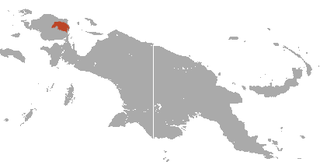
The reclusive ringtail possum or Monk ringtail possum is a species of marsupial in the family Pseudocheiridae. It is endemic to the Arfak Mountains in the Vogelkop Peninsula of West Papua, Indonesia.
The Vogelkop mountain rat, Rattus arfakiensis, is a species of rat native to Indonesia. It is found only in the Bird's Head Peninsula of Papua Province, Indonesia.

The Vogelkop montane rain forests is a tropical moist forest ecoregion in western New Guinea. The ecoregion covers the mountains of western New Guinea's Bird's Head and Bomberai peninsulas.















